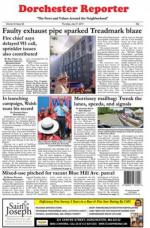August 15, 2024
A group of students from Harvard University’s Extension School who last month spent a good chunk of their summer in Fields Corner observing the neighborhood and compiling suggestions for transportation and climate sustainability, presented their findings during a meeting on Aug. 1 at the Fields Corner Business Lab.
After the speaking part of event, the class of approximately 20 students, along with local partners like Fields Corner Main Streets, Livable Streets, Speak for the Trees, and Boston Food Forest Coalition, who were on hand to listen, took a walking tour of the village.
Beatrice Burgis, who hails from New Jersey, was one of the students who spent four days in Fields Corner making observations at the train station, on the streets, and in interviews with young people in the ADSL summer camp at Town Field as part of a three-week class that involved trips to City Hall and other parts of the city.
“We don’t know the city like you do,” Burgis said. “We aren’t saying anything was done wrong in the past, but just by looking through a new lens to suggest how the city can evolve…We really tried to get a feel for the community so it wasn’t just data on a page, but so we could report what the data felt like on the ground.”
Paul Tuminaro, a Chicago native who is taking the Resilient Communities from the Ground Up course, was impressed with Boston’s work on climate and resiliency goals. “Over half of the 58 projects suggested in Go Boston 2030 are currently underway,” he said. “It’s not just all talk for them.”
The researchers found that Dorchester is quite a bit more dependent on cars that residents in other sections of the city, with 55 percent of Dot residents owning a car vs. 40 percent citywide. It’s also the neighborhood with the most children – with one in four households in Dorchester having children as opposed to one in seven households citywide.
The group recommended such things as dedicated bicycle lanes on Dorchester Avenue to better connect with the Fields Corner station, and more trees in Town Field and the surrounding area. Fields Corner has a 16 percent tree canopy cover currently.
The tree-planting suggestion came with an asterisk as street trees weren’t emphasized due to concerns about blocking businesses/signage or being a sight barrier for all transportation modes. They advocated for “strategically locating trees” where people gather.
The key recommendation was to establish a food forest at Town Field that would offer inter-generational gardening, recreation, and learning – something that is supported heavily by the ADSL camp kids. The group’s design team even created a logo for the ‘Dorchester Food Forest’ that was applied in chalk to various locations around the neighborhood during their study.
They patterned the food forest after the Hope Garden on Geneva Avenue, but noted there is a much bigger opportunity at the larger Town Field due to the ongoing redesign process.
“Maybe some ideas we’re proposing could be accomplished in the Town Field re-design,” said student Nida Bockert, of St. Louis. “There are great opportunities to build on a great foundation.”
Community partners suggested the next round of students in the class focus on the large asphalt parking lot at the Fields Corner mall, particularly when it came to adding trees and resiliency measures. Burgis said they are interested in seeing if the next group takes that on, as they identified it as an area for future study.
“We came to Dorchester four weeks ago as strangers and are leaving now as people who are very interested in the future of this place,” she said.
Instructors for the class included Alison Sant, the lead instructor, and Teaching Assistant Robert Ungar.



